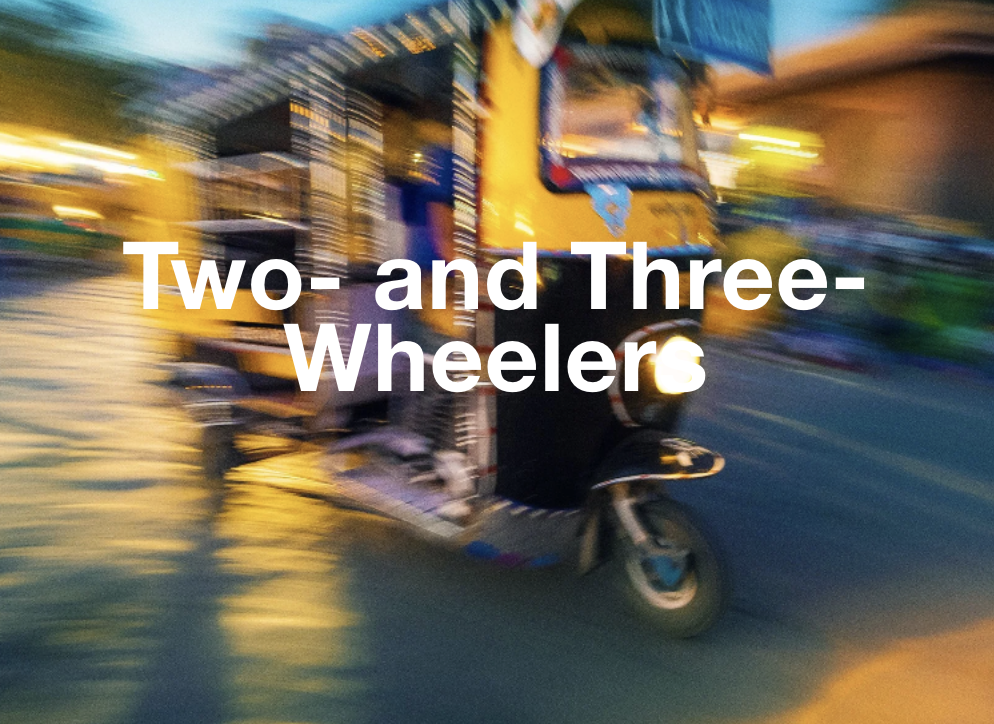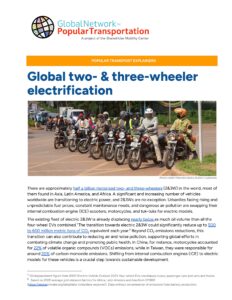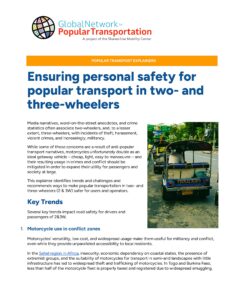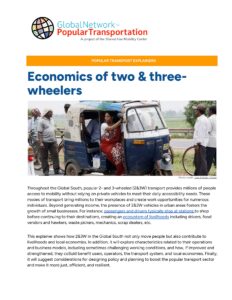Changing Global Narratives and Perceptions of Two- and Three-wheelers
5 minutes Author: Global Network for Popular Transportation Date Launched/Enacted: Nov 13, 2025 Date Published: November 13, 2025

There are at least half a billion motorized two- and three-wheelers (2&3W) in the world today. A growing portion of this global fleet has gone electric and are estimated to already be displacing nearly a million barrels of oil a day.
Vehicles such as tuk-tuks, motorcycles, and scooters are vital to transportation in many cities and towns across the Global South. They offer affordable, accessible, and efficient transport options for millions, especially lower-income households. These vehicles:
-
Provide crucial transportation in areas with limited public transport
-
Help people reach essential services like healthcare, education, and markets
-
Offer livelihood opportunities and support families
-
Are currently cutting greenhouse gas emissions, improving air quality and reducing local air pollution through electrification
However, media coverage often focuses on negative aspects of these transportation modes. A recent media scan, developed by students at Blavatnik School of Government at the University of Oxford in partnership with the Global Network for Popular Transportation (GNPT), showed that 42% of stories about two- and three-wheelers in the media highlight crime, safety issues, and regulatory challenges, while only 38% are positive, and 20% are neutral. These narratives affect popular perceptions and perpetuate the understanding that these modes of transport are unsafe and unsustainable, ignoring their vital contributions to mobility, local economies and even sustainability
Through this project, GNPT aims to promote a more informed view of the essential role that two-and three-wheelers play in cities and towns around the world, acknowledging their importance in daily life, transport accessibility, economic development, and transport decarbonization.
Here are five explainers on topics that we consider are important to tell different, and more representative stories about the role that two- and three-wheelers have around the world:
Electrification: What are the latest trends, technologies and challenges for the electrification of two- and three-wheelers?

The existing fleet of two-wheelers is already displacing nearly four times more oil volume than all the four-wheel passenger EVs combined. The transition towards electric 2&3W could significantly reduce up to 500 to 600 million metric tons of CO2 equivalent each year.
View and download the full Electrification Explainer here.
Alternate versions include Spanish, Portuguese, and French translations.
Equity and Inclusion: How two- and three-wheelers enhance social equity by providing affordable and accessible transport options.

Two- and three-wheelers provide essential, affordable mobility for underserved communities, bridging gaps in public transport and enabling access to jobs, healthcare, and education, but gaps in sustainability and safety remain prevalent.
View and download the full Equity and Inclusion Explainer here.
Alternate versions include Spanish, Portuguese, and French translations.
Road Safety: The policy, infrastructure and regulatory needs to make roads safer for 2&3W drivers and users

Powered 2&3W are improving mobility and sustainability in the Global South but face rising safety challenges, highlighting the need for better infrastructure, stricter helmet laws, and improved driver training to ensure safer roads.
View and download the full Road Safety Explainer here.
Alternate versions include Spanish, Portuguese, and French translations.
Safety and Security: Providing insights on perceptions, realities and strategies to make two- and three-wheelers safer for everyone

This explainer identifies trends and challenges and recommends ways to make popular transportation in 2&3W safer for users and operators.
View and download the full Safety and Security Explainer here.
Alternate versions include Spanish, Portuguese, and French translations.
Economics: The Global South depends on 2&3W for mobility, job creation, and local economies, but informal operations, lack of regulation, and financial barriers often hinder their potential.

This explainer shows how 2&3W in the Global South not only move people but also contribute to livelihoods and local economies.
View and download the full Economics Explainer here.
Alternate versions include Spanish, Portuguese, and French translations.